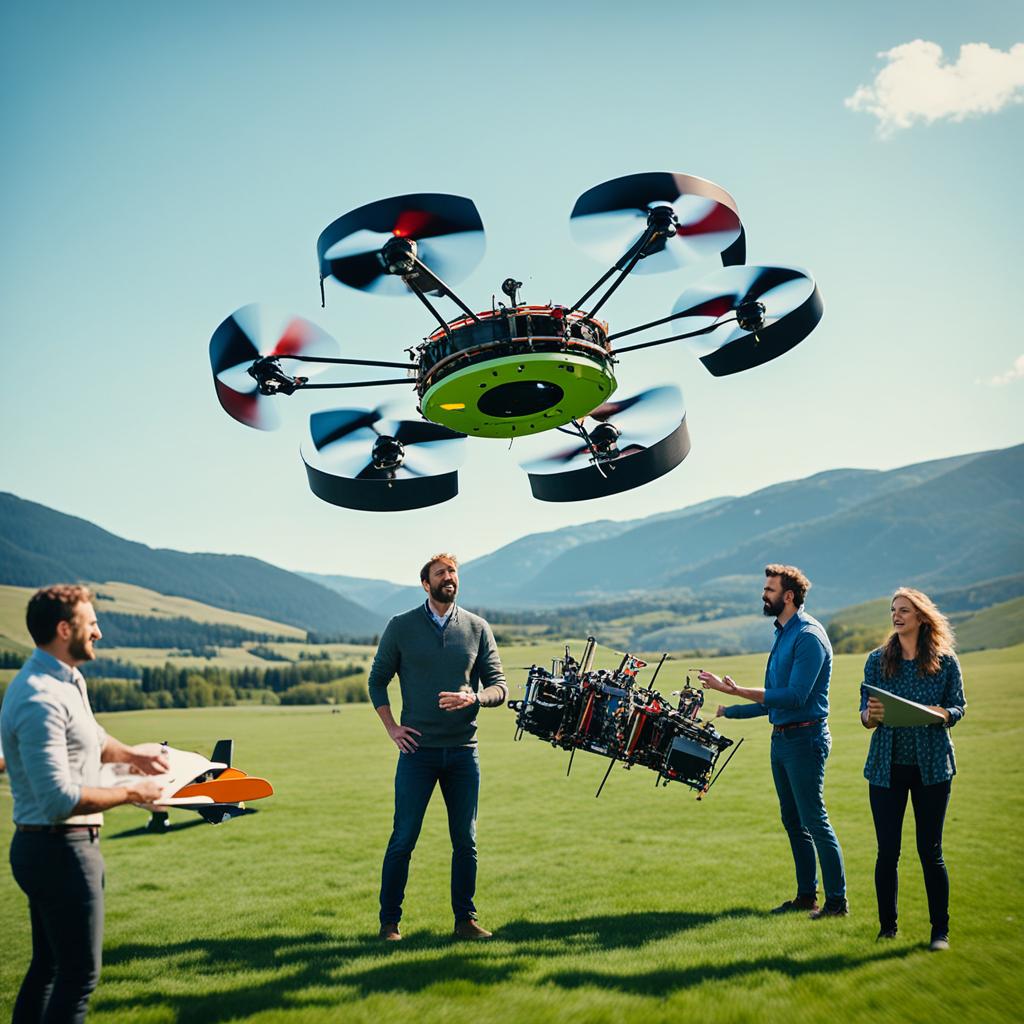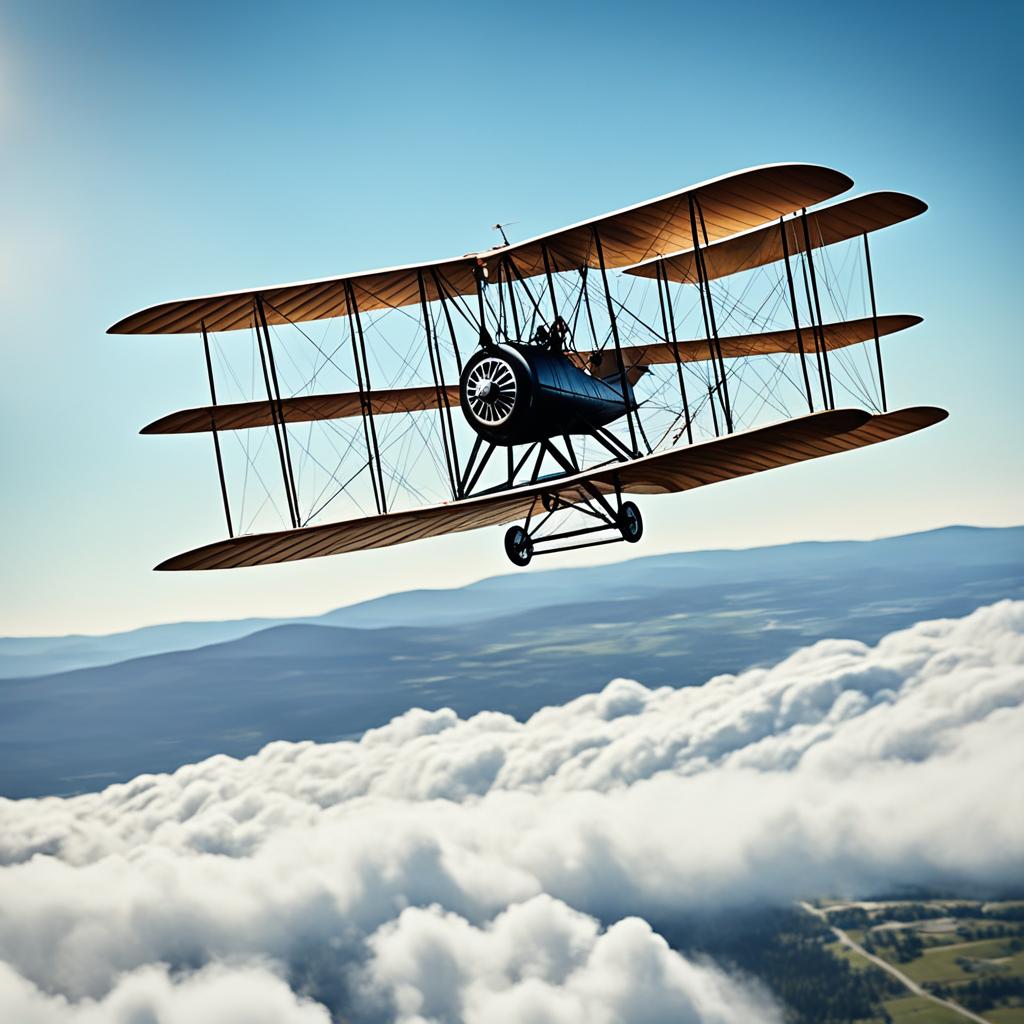Have you ever wondered how the invention of the airplane revolutionized the world we live in today? The importance of this groundbreaking invention goes beyond mere transportation. It sparked a revolution that transformed travel, commerce, and even warfare. So, what makes the airplane’s impact so revolutionary? Let’s explore the incredible significance of this invention and its lasting legacy.
The airplane, invented by the Wright brothers in 1903, brought about a new era of human flight. It allowed people to soar through the sky, experiencing the world from above and changing the way we navigate through space. But its impact was far-reaching and went beyond the realm of leisurely travel.
The invention of the airplane had a profound effect on travel. It broke the barriers of distance, making the world more accessible than ever before. Airplanes enabled people to travel faster and farther, connecting distant countries and continents. The convenience and efficiency offered by air travel brought the world closer together, facilitating cultural exchange, tourism, and international trade.
However, the airplane’s impact extended far beyond the travel industry. It revolutionized commerce, transforming the way goods and materials are transported across the globe. With the advent of air cargo, businesses gained access to a faster and more efficient mode of transportation. Airplanes became key players in the global supply chain, delivering goods rapidly and enabling economic growth worldwide.
The airplane also had a significant role in warfare. Military aircraft played crucial roles in both World Wars, revolutionizing strategic military operations. They were used for reconnaissance, delivering supplies, and even bombing enemy targets. The development of military aircraft advanced rapidly, leading to changes in defense strategies and tactics that shaped the outcome of major conflicts.
So, why was the invention of the airplane so important? Its revolutionary impact on travel, commerce, and warfare transformed our modern world. It sped up global connectivity, facilitated economic growth, and shaped the way nations defend their interests. The airplane continues to leave an enduring legacy, symbolizing human ingenuity and progress. Join us as we delve deeper into the birth of aviation, the achievements of the Wright brothers, and the far-reaching implications of this extraordinary invention.
The Birth of Aviation

Before the invention of the airplane, there were various attempts at human flight, including experiments with balloons and gliders. However, it was the Wright brothers, Orville and Wilbur, who took flight to the next level by creating the first successful heavier-than-air powered aircraft.
Their biplane, fitted with a gasoline engine, made its historic flight in 1903. Lasting just 12 seconds and covering a distance of 120 feet, this monumental achievement marked the birth of aviation as we know it today. The Wright brothers’ breakthrough paved the way for future advancements in aircraft technology.
The Wright Brothers’ Achievements

Orville and Wilbur Wright were not just inventors; they were early aviation pioneers who made significant contributions to the field. Their unique combination of engineering knowledge, skill, and creative abilities led to their success in achieving powered, controlled, and sustained flight.
The Wright brothers conducted extensive research and experimentation to design their aircraft. They meticulously studied the principles of flight, analyzing the works of previous aviation pioneers and conducting their own tests and calculations. Through their investigations, they developed a comprehensive understanding of aerodynamics.
Building upon this knowledge, the Wright brothers built and tested numerous gliders to refine their understanding of flight control. They implemented innovative techniques, such as the three-axis control system, which allowed for stable and maneuverable flight. This breakthrough in aeronautical engineering formed the foundation for all successful airplanes that followed.
Their dedication to aviation research and pursuit of excellence propelled the Wright brothers’ achievements. They constantly sought to improve their designs and techniques, pushing the boundaries of what was thought possible. Their commitment to innovation and attention to detail set them apart from their contemporaries.
Their groundbreaking accomplishments culminated on December 17, 1903, when they made history with the first powered flight. The Wright Flyer, a biplane with a wingspan of 40 feet and a weight of 605 pounds, successfully flew in Kitty Hawk, North Carolina. This milestone flight lasted 12 seconds and covered a distance of 120 feet, forever changing the course of aviation.
Innovation and Legacy
The Wright brothers’ methodical approach to aviation has left an indelible mark on the industry. Their innovative techniques and engineering principles continue to be utilized in modern aircraft design. The development of reliable fixed-wing aircraft paved the way for advancements in commercial aviation, military aircraft, and technological innovation.
By successfully harnessing the power of flight, the Wright brothers unlocked a world of possibilities. Their achievements not only shaped the course of aviation history but also impacted travel, commerce, and warfare. They ushered in a new era of human exploration and opened the skies to a future filled with infinite possibilities.
Note: The image above showcases the Wright brothers during a flight demonstration, highlighting their pioneering achievements in aviation.
The Impact of the Airplane on Travel

The invention of the airplane revolutionized travel, opening up new possibilities for exploration and connection. With the ability to fly, people could now travel faster and farther than ever before, transforming the way we experience the world.
In the early 1900s, airlines emerged, offering passengers the opportunity to journey across countries and continents. This marked a significant shift in the accessibility of travel, making it easier for individuals to explore different cultures, visit loved ones, and expand their horizons. Airplanes became the modern-day vessels of adventure and discovery.
Additionally, airplanes played a pivotal role in the distribution of mail, revolutionizing communication. By taking to the skies, the delivery process became faster and more efficient, connecting people from different corners of the globe.
The impact of the airplane on travel was further amplified by the availability of skilled pilots trained during World War I. With their expertise, airline operations flourished, contributing to the growth of airports and support services. Travel became more streamlined, safer, and convenient, making it accessible to ordinary people.
With air transportation, the world became more interconnected and accessible. No longer confined by geographical limitations, individuals could explore far-off destinations and forge connections with people from diverse backgrounds. The airplane transformed the way we journeyed, turning travel into an experience that transcended borders and brought us closer together.
The Benefits of Air Transportation
- Efficiency: Air travel offers unparalleled speed, allowing individuals to reach their desired destinations in a fraction of the time compared to other modes of transportation.
- Global Accessibility: Airports around the world provide gateways to countless destinations, making it possible for people to easily reach even the most remote locations.
- Business Opportunities: The speed and efficiency of air transportation have enabled businesses to expand their reach, establish international trade relationships, and accelerate global commerce.
- Cultural Exchange: The ease of air travel has facilitated cultural exchange, as people can effortlessly explore different countries, experience diverse customs, and learn from one another.
- Tourism: The airplane has played a significant role in fueling the growth of tourism, making it more accessible and allowing people to explore iconic landmarks and natural wonders around the world.
The impact of air transportation on travel cannot be overstated. It has transformed the way we explore, connect, and experience the world, making the once-unattainable within our reach. The airplane continues to shape the future of travel, enabling us to embark on new adventures and create lasting memories.
The Airplane’s Impact on Commerce
The invention of the airplane not only revolutionized travel, but it also had a significant impact on commerce. With its ability to transport goods and materials quickly and efficiently, the airplane became a game-changer for businesses around the world.
One of the key areas where the airplane made a lasting impact was in air cargo. As air travel became more prevalent and reliable, businesses started utilizing air transportation to ship their products across the globe in record time. The speed and efficiency of air cargo allowed businesses to meet tight deadlines and reach markets that were previously inaccessible. This newfound accessibility opened up opportunities for companies to expand their operations and enter new markets, fuelling economic growth.
The growth of the aviation industry also had a ripple effect on the economy. The demand for airplanes led to the establishment of aircraft construction companies, engine manufacturers, and airport operations. The expansion of these industries created jobs and spurred economic growth in various regions. Additionally, the development of air transportation networks created a domino effect, stimulating the growth of related sectors such as tourism, hospitality, and trade.
Let’s take a closer look at the economic impact of the airplane on commerce with the help of a table:
| Impact Areas | Beneficiaries | Key Effects |
|---|---|---|
| Air Cargo | Businesses, Industries | Shorter shipping times, increased market reach, improved supply chain efficiency |
| Job Market | Workers, Job Seekers | Creation of jobs in aircraft construction, engine manufacturing, airport operations, and related sectors |
| Economic Growth | Communities, Nations | Stimulated economic growth in regions with thriving aviation industries, increased trade and investment opportunities |
As the table illustrates, the impact of the airplane on commerce goes beyond faster transportation. It has influenced supply chains, job markets, and the overall economy, contributing to the development of a thriving commercial sector.
To summarize, the airplane’s impact on commerce has been substantial and far-reaching. From enabling faster air cargo transportation to driving economic growth and job creation, the airplane has become an integral part of global trade. Its impact on commerce continues to shape and propel our modern world forward.
The Airplane’s Role in Warfare
The invention of the airplane had a profound impact on warfare. During World War I and World War II, airplanes played a crucial role in military operations. They were used for reconnaissance, delivering supplies, and bombing enemy targets. The development of military aircraft advanced rapidly during these periods, and airplanes became central to defense strategies and tactics. They allowed for quick deployment of troops and materials, changing the dynamics of warfare. The airplane became a vital tool in national security and defense, shaping the outcome of major conflicts.
In World War I, airplanes were initially used for aerial reconnaissance, providing valuable intelligence on enemy positions and movements. As the war progressed, the military aircraft evolved to take on additional roles. They were equipped with machine guns and bombs, transforming them into formidable weapons on the battlefield. The ability to conduct strategic bombing raids and disrupt enemy supply lines proved to be a game-changer.
In World War II, the importance of the airplane in warfare escalated even further. Both the Allied and Axis powers heavily relied on military aircraft for various combat operations. Air superiority became a critical objective, as control of the skies offered a significant advantage in launching attacks and protecting ground forces. The development of advanced fighter planes, such as the Spitfire and Messerschmitt, showcased the rapid progress in aviation technology during this period.
Strategic bombing campaigns, carried out by heavy bombers like the B-17 Flying Fortress and the Lancaster, played a pivotal role in influencing the outcome of the war. These airplanes could carry substantial bomb loads and fly long distances, allowing them to strike deep into enemy territory. The devastating impact of aerial bombings on cities and industrial centers caused significant damage to enemy morale, infrastructure, and war production.
Additionally, military aircraft played a vital role in transporting troops and supplies across vast distances. The introduction of cargo planes, such as the C-47 Skytrain, facilitated rapid deployments and logistical support, enabling forces to be swiftly moved to the front lines.
The utilization of airplanes for warfare revolutionized the tactics and strategies employed by military forces. The ability to swiftly deploy troops and supplies by air allowed for more flexible and dynamic operations. Airplanes became critical assets in conducting offensive and defensive operations, providing vital support to ground forces.
TABLE
| Advantages of Airplanes in Warfare | Disadvantages of Airplanes in Warfare |
|---|---|
| Ability to gather intelligence from the skies | Vulnerability to anti-aircraft weapons |
| Capability to conduct strategic bombing | Dependence on complex infrastructure and supply chains |
| Swift transportation of troops and supplies | Limited range and endurance |
| Capacity to engage in air-to-air combat | High cost of aircraft production and maintenance |
The strategic importance of airplanes in warfare continues to be recognized in modern times. Military aircraft have evolved with advanced technologies, including stealth capabilities, precision-guided munitions, and unmanned aerial vehicles (UAVs). They are integral in maintaining national security and projecting military power around the world.
The Enduring Legacy of the Airplane
The invention of the airplane by the Wright brothers has had an enduring legacy that continues to shape our world today. Not only did it revolutionize the way we travel, but it also paved the way for numerous technological advancements in aviation. From supersonic transport to jet propulsion, the airplane has been at the forefront of pushing the boundaries of what is possible in flight.
Beyond its technological impact, the airplane holds immense cultural significance. It quickly became a symbol of human achievement and progress, capturing the public’s fascination and inspiring generations to dream big. The airplane’s influence permeated various aspects of society, from the inclusion of flight themes in jewelry and games to its prominence in art and literature.
Today, the airplane remains an integral part of modern life. It connects people across the globe, facilitating business and trade on a global scale. It serves as a reminder of the power of human ingenuity and our ability to defy gravity. The enduring legacy of the airplane is a testament to its profound impact on the world, both technologically and culturally.


